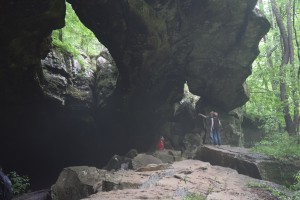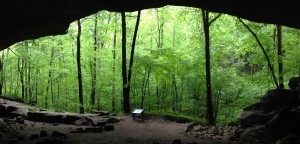
Indian Rockhouse Cave in the Buffalo National River is one of the most spectacular Ozark shelters currently interpreted to the public. It is a large shelter with a natural “skylight, ” and a large spring or underground creek that surfaces briefly at one end of the shelter. It is also the most difficult to access of the four shelters listed on this website. The National Park Service brochure describes the three and a half mile loop trail that takes you to the shelter as moderately strenuous. The emphasis here should be on the word strenuous. The trail head is near the Buffalo Point Ranger Station with parking across the road. The trail is well marked and easy to follow, but there are many uneven stone stairs as well as stretches of steep trail that take you down and back up a 400 foot elevation change. The trail follows a creek that is often dry but can rise quickly after a rain. This is important to know because there are a couple of creek crossings where you will get your feet wet if the creek is up. The hike is certainly worth it because the scenery along the way is beautiful, and the cave at the end is spectacular.

The shelter is impressive as a geological phenomenon. The two most obvious points of interest are the natural skylight which has eroded into the arch of the shelter, and the creek sized spring that emerges from a cave tunnel at the back of the shelter and disappears into the ground again on the other side. The area is clearly underlain by a series of caves and underground creeks channeling the ground water. It is a great example of the karst geology that characterizes the region. You can see another spring on the return part of the loop that emerges from a tunnel into the hillside and joins the creek as well as sink holes formed when parts of the cave system collapsed.
When you arrive you will also see a sign with information about prehistoric use of the shelter. The cave was visited by Samuel Dellinger’s crew from the University of Arkansas Museum in the 1930s. More limited work was also done in the 1970’s. Excavations revealed many stone tools as well as a cache of seeds, nuts, and corn cobs. In the 1960s a radiocarbon date was obtained from the plant material in the cache. The sample dated to approximately 1350 A.D. This means that 200 years before De Soto came to Arkansas, and 500 years before permanent American settlement in the
Ozarks, Native Americans were using this shelter to store corn and other food. While this is the only “hard date” we have for the shelter, the stone tools found here tell us that this location was being used well before 1350. The oldest artifacts associated with this site date back 9,000 years. This shelter has been intermittently used ever since.

The other important discovery at this site was the grave of a very young child wrapped in an animal hide and buried in a clay lined pit in the shelter along with a turtle shell and bone and stone tools. The presence of this burial, among other reasons, makes this shelter a sacred space to Native Americans. Enjoy the shelter on your visit, appreciate the natural beauty, the thousands of years of history, and respect the site as sacred by treating the shelter with respect.